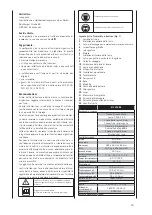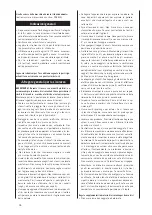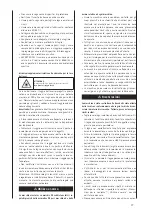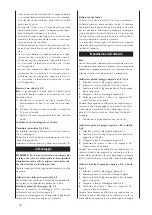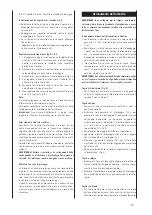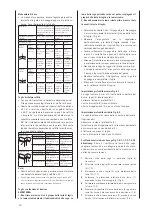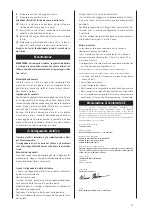
16
towards you during the cut. the blade may try to climb up on
the top of the workpiece, causing the cutting head assembly
and spinning blade to kick back.
2. Never lower the spinning saw blade down before pulling
the cutting head to the front of the saw.
• Unlock the carriage 1 with the lock handle 2 and al-
low the cutting head assembly to move freely. (Fig. 6)
• Move the mitre handle and cutting head to the desired
mitre angle and bevel angle according to the mitre cut
and bevel cut procedures.
• Grasp the saw handle and pull the carriage forward
until the centre of the saw blade is over the front of
the work piece.
• Activate the switch, then press the blade guard lock
lever to lower the cutting head down.
• When the saw reaches full speed, push the saw han-
dle down slowly, cutting through the leading edge of
the workpiece.
• Slowly move the saw handle toward the fence, com-
pleting the cut.
• Release the switch and allow the blade to stop spin-
ning before allowing the cutting head to raise.
Depth adjustment normal Fig. 6.1
Sawing function 5 mm below the table top. (separate
work pieces.)
Lift the depth stop (1).
Stop screw (2) is used.
Setscrew (3) has no function.
Depth adjustment variable Fig. 6.2
Sawing function above the table top. (covered cuts)
Lower the depth stop (1).
Set the setscrew (3) to the desired measurement and
secure it with the counternut (4).
Make a test cut.
Stop screw (2) is not used.
Carrying the tool
• Loosen the mitre lock knob and turn the table all the
way to the right. Lock the table at 45° mitre angle.
• Push the cutting head backwards and lock the car-
riage.
• Lower the cutting head and push in the lock pin.
• Carry this mitre saw with the built-in carry handle and
the side of the base.
Replacing the Saw Blade Fig. 7.0-7.1-7.2-7.3-7.4
Caution:
Before replacing saw blades, shut off the
machine and disconnect the plug from the mains supply,
so that you can prevent any injuries in case the machine
is started accidentally.
1
Place the saw unit in chop cutting position.
2
Loosen the slotted screw (B) and remove the guiding
lever (A). (7.0)
3
Remove the slotted screw (C) on the saw blade guard
(D). (7.1)
4
Unlock the lower saw blade guard (7) by pressing the
clamping lever (3) (Fig.1)
5
Lift the lower saw blade guard to release the saw
blade. (7.2)
6
Press saw blade lock (E), turn the saw blade (8) until
the lock clicks into place. (7.3)
7
Loosen the saw blade lock screw (F) using the
supplied key (G) (caution: left-hand thread) (7.4)
8
Remove the screw and the saw blade flange.
9
Carefully remove the saw blade.
Caution: Risk of injury caused by the saw blade.
10
Before installing the new saw blade, clean the inner
and outer flange with a cloth.
11
Install a new saw blade, pay attention to the correct
size and direction of the saw blade.
12
Install the outer saw blade flange and firmly tighten
the screw.
13
Mount the saw blade guard (D) and the guiding lever
(A) again, observe the correct position.
Perform a function test before switching the machine on
Maintenance
WARNiNG: For your own safety, turn the switch off and re-
move the plug from the power source outlet before maintain-
ing or lubricating your mitre saw.
General Maintenance
Occasionally use a cloth to wipe off chips and dust from
the machine. Oil the rotary parts once a month to extend
the tool life. Do not oil the motor.
Brush inspection
Check the motor brushes after the first 50 hours of use
for a new machine or after a new set of brushes have
been installed. After the first check, examine them every
10 hours of use.
When the carbon is worn to 6 mm in length or if the
spring or shunt wire is burned or damaged, replace both
brushes. If the brushes are found serviceable after remov-
ing, reinstall them.
m
Electrical connection
the installed electric motor is completely wired ready for
operation.
the customer’s connection to the power supply system, and
any extension cables that may be used, must conform with
local regulations.
important remark:
The motor is automatically switched off in the event of
an overload. The motor can be switched on again after a
cool ing down period that can vary.
Defective electrical connection cables
Electrical connection cables often suffer insulation dam-
age.
Possible causes are:
• Pinch points when connection cables are run through
window or door gaps.
























